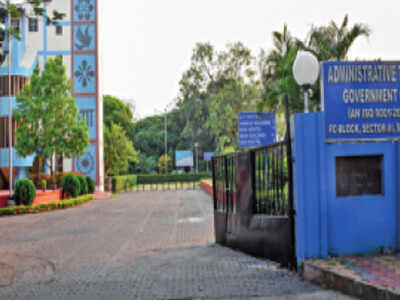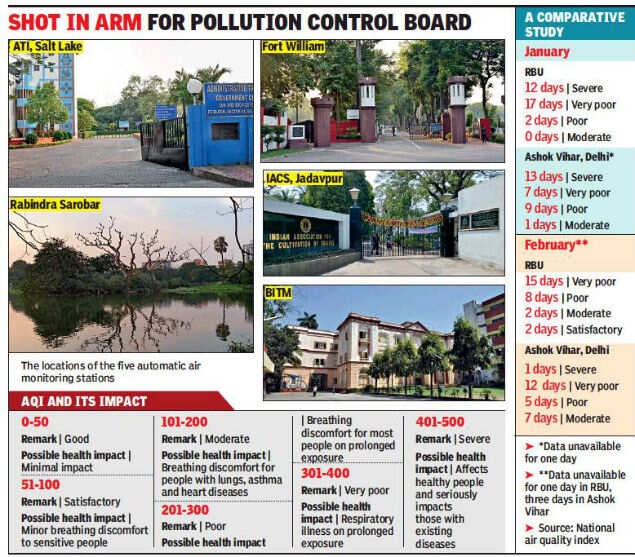
KOLKATA: Two continuous ambient air quality monitoring stations (CAAQMS) will start functioning from Wednesday and another three by the end of this month. The Administrative Training Institute (ATI) in Salt Lake, Rabindra Sarobar, Birla Institute of Technological Museum (BITM), Indian Association of Cultivation of Science (IACS) in Jadavpur and Fort William will get one each of the automatic air-monitoring stations.
Track the pollution level in your city
“We are trying our best to make air-quality data from these five stations live on the national air quality index grid by the end of this month,” said West Bengal Pollution Control Board (WBPCB) member secretary Niraj Singhal. According to WBPCB sources, two of these stations — the ones at ATI and Fort William — will go live by Wednesday.
Besides these CAAQMS, WBPCB runs 16 manual air-quality monitoring stations, which run twice a week. But these stations don’t reveal the true picture of the city’s ambient air quality. Moreover, real-time data is not available and the information available is subject to manipulation. WBPCB came under severe criticism for shutting CAAQMS in the later part of 2017, when the city’s air quality started declining.

Though the new CAAQMS are starting to operate, none of these stations, environmentalists said, is located in areas where pollution shoots through the roof. For example, Behala Chowrasta, Moulali or Shyambazar five-point crossing were found to be the most polluted in the interim source apportionment study report of the National Environment Engineering Research Institute (NEERI). But they admitted that the number of monitoring stations needed to go up to get an overview of the city’s ambient air. While Delhi has as many as 19 such stations, Bengaluru has 10, Hyderabad six and Lucknow has four.
“Since Delhi has so many monitoring stations, people get to know their neighbourhood’s ambient air quality and take steps accordingly. Their reaction finds popular resonance in media and the government’s policy decision. Such a practice is absent in Bengal,” said Subhas Dutta, a green crusader who has been fighting numerous legal battles to arrest the city’s declining ambient air quality. According to Dutta, Kolkata must have many more CAAQMS to track the city’s air quality. “It is the right of citizens to know the ambient air quality of a place at a particular time. It is a global practice to inform citizens about the air quality through multiple CAAQMS,” he added.
Over the last few years, the pollution level in Kolkata’s air has been as high as Delhi’s and on several occasions, even higher than the Capital. If Rabindra Bharati University (RBU) had 12 ‘severe days’ and 17 ‘very poor days’, Ashok Vihar in Delhi had 13 ‘severe days’ and 7 ‘very poor days’ in January.
According to many, it is not advisable to always depend on the CAAQMS. “We need workable data even if it is not 100% accurate. Low-cost real-time sensors can achieve this. We need to expand our monitoring network to check pollution levels in smaller towns and rural areas. That can’t be done only with sensors that can give accurate data but are very expensive. This is why the environment department in association with World Bank has set up more than two dozens of such devices across the city. But those data are not available in the public domain,” said a senior environment department officer.
Track the pollution level in your city
“We are trying our best to make air-quality data from these five stations live on the national air quality index grid by the end of this month,” said West Bengal Pollution Control Board (WBPCB) member secretary Niraj Singhal. According to WBPCB sources, two of these stations — the ones at ATI and Fort William — will go live by Wednesday.
TimesView
This is a step in the right direction. More monitoring stations spread over a larger expanse will give us a better idea of the more polluted areas of the city and help planners go in for area-specific solutions.
Besides these CAAQMS, WBPCB runs 16 manual air-quality monitoring stations, which run twice a week. But these stations don’t reveal the true picture of the city’s ambient air quality. Moreover, real-time data is not available and the information available is subject to manipulation. WBPCB came under severe criticism for shutting CAAQMS in the later part of 2017, when the city’s air quality started declining.

Though the new CAAQMS are starting to operate, none of these stations, environmentalists said, is located in areas where pollution shoots through the roof. For example, Behala Chowrasta, Moulali or Shyambazar five-point crossing were found to be the most polluted in the interim source apportionment study report of the National Environment Engineering Research Institute (NEERI). But they admitted that the number of monitoring stations needed to go up to get an overview of the city’s ambient air. While Delhi has as many as 19 such stations, Bengaluru has 10, Hyderabad six and Lucknow has four.
“Since Delhi has so many monitoring stations, people get to know their neighbourhood’s ambient air quality and take steps accordingly. Their reaction finds popular resonance in media and the government’s policy decision. Such a practice is absent in Bengal,” said Subhas Dutta, a green crusader who has been fighting numerous legal battles to arrest the city’s declining ambient air quality. According to Dutta, Kolkata must have many more CAAQMS to track the city’s air quality. “It is the right of citizens to know the ambient air quality of a place at a particular time. It is a global practice to inform citizens about the air quality through multiple CAAQMS,” he added.
Over the last few years, the pollution level in Kolkata’s air has been as high as Delhi’s and on several occasions, even higher than the Capital. If Rabindra Bharati University (RBU) had 12 ‘severe days’ and 17 ‘very poor days’, Ashok Vihar in Delhi had 13 ‘severe days’ and 7 ‘very poor days’ in January.
According to many, it is not advisable to always depend on the CAAQMS. “We need workable data even if it is not 100% accurate. Low-cost real-time sensors can achieve this. We need to expand our monitoring network to check pollution levels in smaller towns and rural areas. That can’t be done only with sensors that can give accurate data but are very expensive. This is why the environment department in association with World Bank has set up more than two dozens of such devices across the city. But those data are not available in the public domain,” said a senior environment department officer.
Make sense of the 2019 Lok Sabha elections and results on May 23 with The Times of India. Follow TOI to track latest news, live updates, news analysis and cutting-edge data analytics. Track live election results, the big trends and fastest news updates from each of India's 543 Lok Sabha constituencies on the counting day with India's largest news network.
#ElectionsWithTimes
Elections 2019

Trending Topics
LATEST VIDEOS
More from TOI
Navbharat Times
Featured Today in Travel
Quick Links
Lok Sabha Election Schedule 2019Lok Sabha Election NewsDelhi Capitals teamMI team 2019Rajasthan Royals 2019RCB team 2019Maharashtra Lok Sabha ConstituenciesBJP Candidate ListBJP List 2019 TamilnaduShiv Sena List 2019AP BJP List 2019Mamata BanerjeeBJP List 2019 MaharashtraPriyanka GandhiBJP List 2019 KarnatakaAMMK Candidate List 2019BJP List 2019 WBLok Sabha Elections in Tamil NaduBSP List 2019 UPNews in TamilLok Sabha Poll 2019Satta Matka 2018PM ModiMahagathbandhanNagpur BJP Candidate ListChandrababu NaiduTamil Nadu ElectionsUrmila MatondkarNews in TeluguMadras High CourtTejashwi YadavArvind KejriwalTejasvi SuryaPawan KalyanArvind KejriwalYogi AdityanathJaya PradaSatta King 2019Srinagar encounter
Get the app










